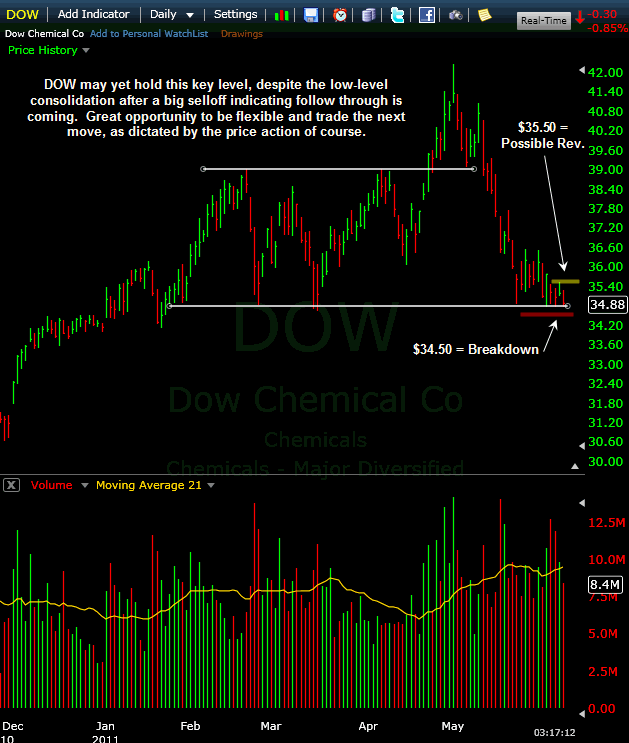 All Entries in the "Trading Tips" Category
All Entries in the "Trading Tips" Category
3 Signs You Have a Home Run Trade
September 7, 2011 at 10:21 am
 Here’s 3 signs you have a home-run trade on your hands:
Here’s 3 signs you have a home-run trade on your hands:
* Your initial target gets reached faster than expected. Ideally, this is also accompanied by heavy volume to confirm the move. Either way, this is a stock that’s getting quickly on the move, and you’re participating – congrats.
* You get runaway gaps in your favor. A runaway gap is an indication that emotions are heating up and traders are becoming impatient. With prices moving in your favor, you’re in good shape to capture additional momentum and be able to offer out stock at higher levels.
* Your stock has a historical propensity to make big moves. This factor alone isn’t enough to produce a home-run, but with either (or both) of the previous two at work, it only adds to the likelihood that the move getting underway is going to pay you well.
Momentum trading requires a different mindset, and momentum arrives when there’s more emotion present than logic. Keep this in mind the next time you have a trade performing better than expected, and see how much you can get out of it.
Trade Like a Bandit!
Jeff White
Producer of The Bandit Broadcast
Follow TheStockBandit on Twitter or get our free newsletter to keep up!
A Good Market
August 6, 2011 at 7:15 am
Every trader is different from the next in our timeframe or directional bias or risk tolerance. That’s what makes a market, so it’s a good thing. We’re also each unique individuals, so it’s no surprise we might each have differing definitions of our favorite market conditions.
Regardless of what your ideal market looks like, it may only come around a couple of times per year. You’ll of course need to make the most of it when those conditions are present, but what about the rest of the time? Isn’t it important for us to capitalize on a good market?
Of course it is, but not everyone understands what that looks like.
Today I want to point out a post from the archives that’s every bit as pertinent to current market conditions as it was when it was first written. Check out this post for a few items to watch for that’ll improve the trading conditions when they arrive – and they will arrive.
Here’s the post: What Makes a Good Trading Market?
Trade Like a Bandit!
Jeff White
Producer of The Bandit Broadcast
Embracing Market Changes
August 5, 2011 at 7:15 am
 The market is ever-changing, both in what it fixates on and in how it moves. At times it’s earnings, at other times it’s politics, and still other times it’s the economy. Sometimes it sprints, sometimes it crawls, and sometimes it jumps back and forth across the same line to get nowhere.
The market is ever-changing, both in what it fixates on and in how it moves. At times it’s earnings, at other times it’s politics, and still other times it’s the economy. Sometimes it sprints, sometimes it crawls, and sometimes it jumps back and forth across the same line to get nowhere.
As traders, it’s this constant change which actually provides us with serious opportunity. The long-term buy-and-hope type doesn’t have a different approach for profiting from a momentum market vs. a sharp correction. You as a trader do, so embrace that!
When it’s time to adapt, be willing to do it. The same old patterns might not work, so at times you’ll need to modify what you’re looking for and go with something a little different. Experience will teach you this, but right alongside that is your ongoing willingness to listen to the market and identify what’s working.
I want you to check out this post from the archives where I talk about Profiting From Market Changes – you’ll learn from it.
Trade Like a Bandit!
Jeff White
Producer of The Bandit Broadcast
Elevating Your Odds
August 3, 2011 at 6:05 am
 Each of us would say we want every advantage possible in our favor, regardless of the activity. But a closer look at your trades would likely reveal occasions where you didn’t quite wait for all the elements of your trading plan to come together.
Each of us would say we want every advantage possible in our favor, regardless of the activity. But a closer look at your trades would likely reveal occasions where you didn’t quite wait for all the elements of your trading plan to come together.
Perhaps that’s out of impatience or anxiety, but we’ve all done it and either suffered diminished returns from lowering our standards or we’ve implemented some poor habits which came back to bite us later.
When it comes to daytrading, our greatest odds for success come when we combine multiple favorable conditions before placing trades. That might be locating setups which point to the same outcome on multiple timeframes, or it might be considering the overall market environment and trading in such a way that we’re not fighting that.
Go check out this post from the archives which has both a written explanation & a video showing you what I mean, because the key is to Stack the Odds for Daytrading Success.
Trade Like a Bandit!
Jeff White
Producer of The Bandit Broadcast
Pro’s Are Patient
July 18, 2011 at 9:11 am
The British Open is my favorite major to watch. It requires so much of the players, from execution to mental toughness to using their imagination to get the ball in the hole. Plus, it happens in July when it’s 147 degrees here in Texas, and I like to disappear into the home theater where it’s cool and dark and watch the guys wearing sweaters as they fight the sideways rain squalls!
 In watching yesterday’s final round, the leaders were each asked during their pre-round prep what the most important element would be for their game in the final round. Without exception, they all said the same thing: Patience.
In watching yesterday’s final round, the leaders were each asked during their pre-round prep what the most important element would be for their game in the final round. Without exception, they all said the same thing: Patience.
Experience taught them that. Eventual winner Darren Clarke was quick to admit he’s not normally a patient person, yet that was his focus as he headed out to try to claim his first major title.
A little gray hair goes a long way.
Had it been an interview with amateur leaders of the local club championship, the answers given may have been along the lines of “I need to make a lot of birdies.” And while that may be true, it’s not the priority of a pro when conditions are less than ideal.
True Confidence
Patience is not my strongest suit. I’m aware of it though, and therefore continue to keep impatience in check. I have to work on it. Self-honesty is important though, so I can’t ignore the occasions where impatience costs me opportunity, and those in turn serve as reminders to wait for the best opportunities to come along.
Through my premium service, I encounter a lot of traders who are overly anxious. Impatient doesn’t even begin to describe them. They’re willing to throw caution to the wind just for the thrill of being in something.
Or to avoid looking scared.
I think they fear it’s a show of cowardice if they sit on the bench for a little while. Ironically though, the biggest sign of confidence that you know what you’re doing is having the guts to sit on your hands when you don’t see what you like. You don’t chase the wind – you have a plan, and you execute it when the time is right.
Instead of taking that approach, these highly impatient traders don’t realize the primary importance of preserving capital and the secondary aim of turning a profit. Instead, they want to be highly active every day, and it’s as though they’re missing out if they exercise some caution. I don’t mind telling them that my service isn’t the right fit for those who feel the continual need to be in something.
Wait For It
The fact of the matter is that there are times when the sidelines are the best place to be. Just like the British Open leaders identified the greatest virtue of the day to be patience in the face of harsh weather conditions and tremendous pressure, you as a trader have to recognize when patience is the best course of action for you.
You’re still agile enough to take action should conditions present an opportunity, so it’s not as though you’re immobilized or stuck like a buy-and-hope investor type. But when the market is overly sensitive to the news flow, we’re getting huge gaps on nearly a daily basis, reversals are happening frequently, and the setups are sparse, the best course of action is to take very little to no action.
We all know the oft-used quote from Jim Rodgers, but it’s this kind of attitude I’m referring to…
“I just wait until there is money lying on the corner, and all I have to do is go over there and pick it up. I do nothing in the meantime. Even people who lose money in the market say, ‘I just lost my money, now I have to do something to make it back.’ No you don`t. You should sit there until you find something.”
If you’re predisposed to trading the long side, then wait for market weakness to dissipate before committing capital. If you like the short side and we’re seeing relentless rallies, the only thing you’re missing out on by not trading is pain. Recognize that and embrace the option of doing nothing when what you see doesn’t fit your skill set.
Professionals know there are times to lay low and wait for the best opportunities, but amateurs tend to force the issue out of impatience. Which would you rather be?
Trade Like a Bandit!
Jeff White
Producer of The Bandit Broadcast
Obscurity and Opportunity
June 28, 2011 at 8:57 am
Prolonged market rallies have a way of pulling obscure stocks off the sidelines and getting them involved in the action. It’s the effect of “a rising tide lifts all boats.”
And that’s entirely fine. It’s nice when new names are added to the mix of active stocks.
The market turned higher in March 2009, and since then we’ve seen considerable progress. Tons of little names have entered the fray, paying astute traders along the way (unintentional rhyme).
While I do have some restrictions on what I will and will not trade, I don’t mind trading some of the more obscure names when they’re set up for moves – so long as they exhibit the proper traits:
Size Matters
 Dirt-cheap, thin stocks are not worth trading. They carry much greater potential for pain than profit, despite their inexpensive price tags. But growing stocks (price & volume growth, not necessarily earnings growth) are another story. Every big run starts somewhere, right?
Dirt-cheap, thin stocks are not worth trading. They carry much greater potential for pain than profit, despite their inexpensive price tags. But growing stocks (price & volume growth, not necessarily earnings growth) are another story. Every big run starts somewhere, right?
There’s often a relationship between ‘unknown’ and ‘underowned’ and that can spell exceptional opportunity. Under-the-radar stocks often times begin to exhibit technical characteristics worth noting, raising interest in them in such a way that they’re the up-and-coming stocks. Naturally, they’re little-known, and that means they’re underowned by institutions (the ones who really move stocks). As they exhibit some staying power, interest in them grows. That brings both price and volume up to tradeable levels, placing them squarely on the watch lists of traders like you and me.
(I’m talking to mostly guys here, so ladies please bear with me on this next analogy. I want these guys to “get it” so they know what I’m talking about.)
Think of that co-ed in college who returned from summer looking far better than the previous semester. What happened? Suddenly she has the attention of many more guys, has more dates, and as competition for her time expands, so does her confidence. Now that she’s being noticed, she’s unlikely to regain the 15 she lost and return to the sweats-with-no-makeup look again. (Nothing against the natural, casual look… just stating that a change is likely to last in this case). She’ll quite likely take care of herself better, and interest in her will be maintained as a result.
Stocks sometimes follow a similar path.
Beware the Flash in the Pan
As the phrase states, “one day does not a trend make.” Therefore, it makes sense to make a stock prove itself – at least for a little while – before taking a position.
The single-day spurt higher on news will bring no-name stocks into view on a regular basis, but most of those are just having their 15 minutes of fame. If what you’re seeing is just a knee-jerk response to a headline, there’s limited opportunity and that stock is likely to drift right back into obscurity. Avoid those.
Instead, as a stock begins to earn respect (and attention), watch for the key characteristics that it’s starting to trend: expanding volume, higher highs and higher lows, and a good price/volume relationship. These stocks are much more likely to stick around and offer you multiple opportunities to participate and profit.
Trade Like a Bandit!
Jeff White
Producer of The Bandit Broadcast
Trading Against Key Levels
June 9, 2011 at 8:17 am
Pattern traders, technicians, and active traders in general love to watch for key levels. To some, it’s obvious to expect a reversal if that level is reached, while others expect a break.
Both sides have their case, and frankly, that’s what makes a market!
Today I wanted to point out an example of a stock I’ve been watching which has yet to do either. A key level – which has been tested multiple times not only in recent months but also in recent days – is the focal point right now, and one way or another I think there’s going to be a play. Here’s the setup:
DOW is clearly not in great shape here, as we’ve seen a steady slide from the May highs with every little bounce attempt getting sold. Plenty of distribution too as volume has spiked numerous times on recent selloffs. For the past 2+ weeks, the stock has lingered right near key support, looking like it could crack any day.
And yet it hasn’t.
The market overall has been very weak. The stock itself has yet to bounce, but it’s also ignoring a textbook breakdown opportunity here to really crack. And that has my attention.
At the start of this post, I mentioned how some traders are predisposed to watch for reversals and others watch for breakouts/breakdowns. I’m in the latter camp most of the time, and especially when the stock is consolidating against that level. DOW has been on my watch list for a breakdown in recent days, but I have yet to take an entry (since it hasn’t happened yet).
Currently, with the market oversold and this stock hanging tough like a NKOTB, I’m now open to a trade in the other direction (upside reversal). Isn’t that one of the huge advantages of trading the market? It’s like putting money on a horse when it’s running the back stretch, well after the race has started. The willingness to switch directions or modify (or reverse) an opinion is something flexible traders must have. This is one of those chances.
How I’ll approach this one is to use $35.50 (multi-day high) as a pivot for getting long, and $34.50 (breakdown) as a pivot for going short.
Trade Like a Bandit!
Jeff White
Producer of The Bandit Broadcast






